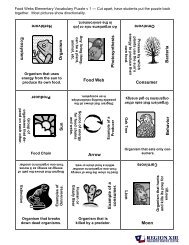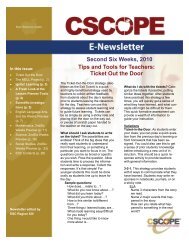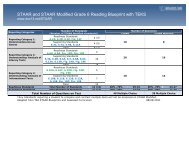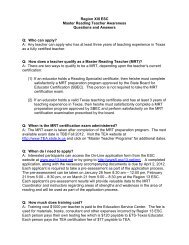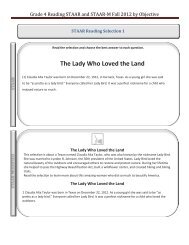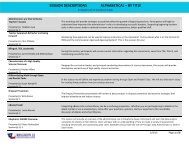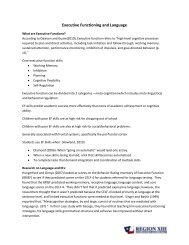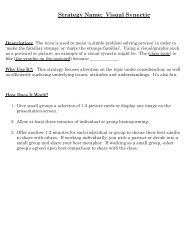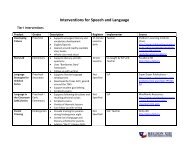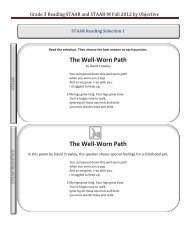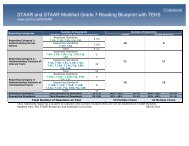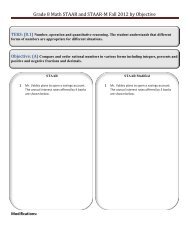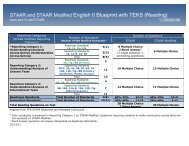Read Aloud: Good Thing You're Not an Octopus Using ... - Region 13
Read Aloud: Good Thing You're Not an Octopus Using ... - Region 13
Read Aloud: Good Thing You're Not an Octopus Using ... - Region 13
You also want an ePaper? Increase the reach of your titles
YUMPU automatically turns print PDFs into web optimized ePapers that Google loves.
School <strong>Read</strong>y Collaborative Lesson Pl<strong>an</strong><br />
<strong>Read</strong> <strong>Aloud</strong>: <strong>Good</strong> <strong>Thing</strong> You’re <strong>Not</strong> <strong>an</strong> <strong>Octopus</strong> <strong>Using</strong> a Graphic Org<strong>an</strong>izer<br />
Book: <strong>Good</strong> <strong>Thing</strong> You’re <strong>Not</strong> <strong>an</strong> <strong>Octopus</strong>!<br />
Author: Julie Markes<br />
Pre‐k Guidelines Addressed in this lesson<br />
Emergent Literacy –<strong>Read</strong>ing III.D.3.Child asks <strong>an</strong>d <strong>an</strong>swers appropriate questions about the book<br />
Emergent Literacy‐Writing IV.A.1. Child intentionally uses scribbles/writing to convey me<strong>an</strong>ing<br />
Lesson <strong>Not</strong>es<br />
X 1 st read ”2 nd read 3 rd read 4 th read<br />
Before<br />
<br />
During<br />
<br />
Share your objective or “Adv<strong>an</strong>ced Org<strong>an</strong>izer” for the lesson. Example: “We’re going to read this book<br />
to learn why this little boy does not w<strong>an</strong>t to be octopus, a shark, or <strong>an</strong>y other kind of <strong>an</strong>imal. As we<br />
read I’m going to ask you some questions about what you think. Afterwards we’re going to write a<br />
letter to one of the <strong>an</strong>imals <strong>an</strong>d share our thoughts.”<br />
Once children have recognized the pattern of the book (about 3‐4 <strong>an</strong>imals into the story), ask open<br />
ended questions before you share what each <strong>an</strong>imal does (e.g., before you read “If you were a bear,<br />
you would have to nap all winter long!”)<br />
Examples:<br />
“Why do you think it’s a good thing he’s not a bear” or “Why do you think he doesn’t w<strong>an</strong>t to be a<br />
bear”<br />
“How might a (name of the <strong>an</strong>imal) do (name of action)” (e.g. “How might a bear take a nap”)<br />
“Would you like to (name of action <strong>an</strong>imal does) Why” (e.g., “Would you like to ride in your mother’s<br />
pouch Why/why not”)<br />
*Offer scaffolds as needed. (e.g., “Do you think he doesn’t w<strong>an</strong>t to be a bear because he likes sleeping<br />
a long time or because he doesn’t like sleeping a long time”)<br />
After<br />
<br />
<br />
Ask the students if they would like to be a particular <strong>an</strong>imal in the story (e.g., <strong>an</strong> octopus.) They may<br />
show you their preference nonverbally by putting their thumbs up, sideways, or down. Explain that you<br />
(the teacher) would not like to be that <strong>an</strong>imal <strong>an</strong>d that the class is going to write their ideas down in a<br />
letter to that <strong>an</strong>imal to tell it why.<br />
Explain what a letter is. (e.g., “A letter is a written message that starts like this: Dear_____,) Show <strong>an</strong><br />
example, if possible.<br />
ESC <strong>Region</strong> XIII © 2011
Write a letter to one of the <strong>an</strong>imals in the story explaining why you are glad you are not the <strong>an</strong>imal.<br />
You c<strong>an</strong> select the <strong>an</strong>imal ahead of time or select it based on student interest.<br />
Feel free to begin the letter by repeating what was in the book. (e.g., “I’m glad I’m not you because I’d<br />
have 8 legs.” or “I’m glad I’m not you because I’d have to put on 8 shoes.”)<br />
Prompt students’ thinking with questions as needed.<br />
Examples:<br />
“Why are you glad you’re not <strong>an</strong> octopus”<br />
“Where does <strong>an</strong> octopus live Would you like to live there”<br />
“What does <strong>an</strong> octopus eat Would you like to eat that”<br />
“What does <strong>an</strong> octopus look like Would you like to look like that<br />
“Would could you not do if you were <strong>an</strong> octopus”<br />
Optional: Use a real photo of the <strong>an</strong>imal to prompt the children’s thinking.<br />
<br />
<br />
<br />
<br />
Draw a quick, simple pictorial representation of each sentence. (e.g., a picture of a shoe)<br />
“Think aloud” as you write, sharing some of the print conventions you are following: moving from left<br />
to right, leaving a space between words, return sweep, <strong>an</strong>d punctuation.<br />
Complete 2 or more phrases of “I’m glad I’m not you because…” depending on time available.<br />
Finish the letter with a salutation (e.g., Sincerely, Ms.Bubble’s class) or return to the letter during<br />
<strong>an</strong>other lesson to add more sentences before writing the salutation. You may invite each student to<br />
sign his/her name on the letter after the lesson.<br />
Materials<br />
Book<br />
Poster or piece of chart paper to write letter on<br />
Box of assorted markers<br />
Optional: real photo of one or more <strong>an</strong>imals in the story<br />
Optional: a real letter to share with the students<br />
Extensions<br />
“Mail” your letter to the <strong>an</strong>imal. Then, write a reply letter to your class from the <strong>an</strong>imal (e.g., a letter<br />
from octopus) <strong>an</strong>d read it together.<br />
<br />
Invite each student to dictate to you why she’s glad she’s not <strong>an</strong> octopus. Record her words <strong>an</strong>d ask<br />
her to draw <strong>an</strong> illustration. Create a class book out of the drawings.<br />
ESC <strong>Region</strong> XIII © 2011



